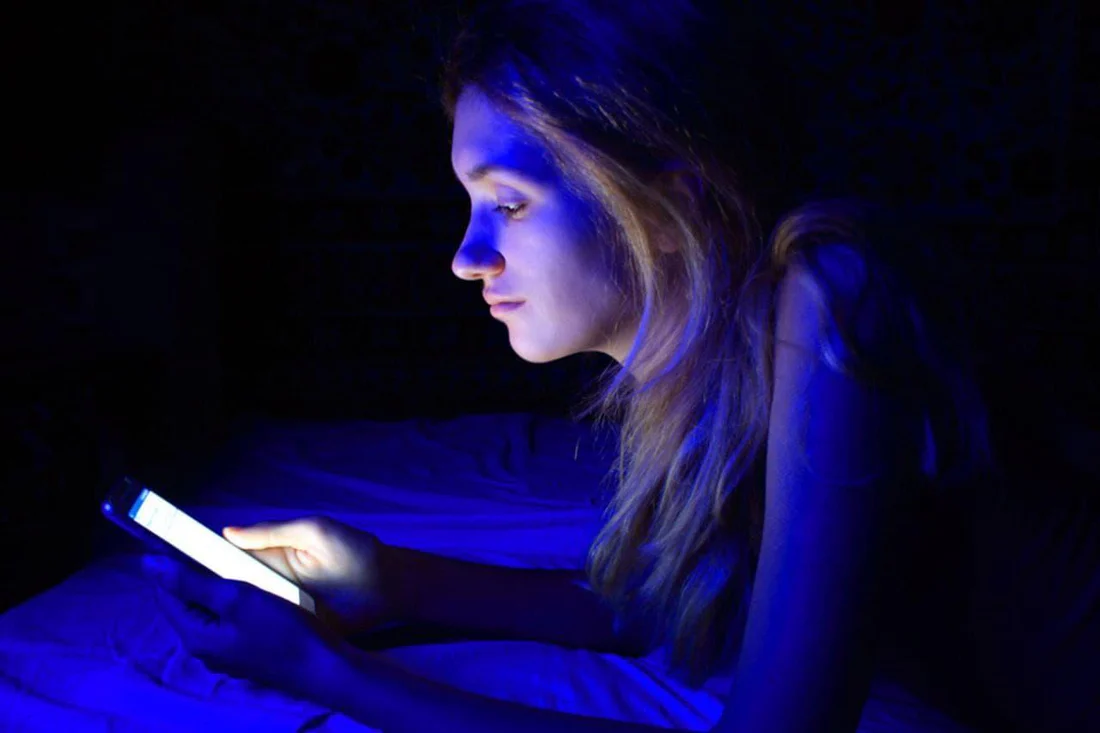Introduction
In the digital era, our eyes are exposed to blue light from many sources: smartphones, computers, TVs, LED lights. While UV rays have long been a concern, the harmful effects of blue light are the “silent killer” accelerating eye aging. Ophthalmology studies show that excessive blue light exposure not only causes eye strain and sleep disturbances but also speeds up macular degeneration and premature retinal aging.
What is Blue Light?

Blue light at night accelerates eye aging
Blue light is the visible light spectrum with a wavelength of 400–500 nm, carrying higher energy than other light bands. Sources include sunlight, electronic device screens, and modern LED lighting. Unlike ultraviolet (UV) rays which are mostly absorbed by the cornea and lens, blue light can penetrate deeply into the retina – the most delicate area that determines detail and color vision.
Potential Harms of Blue Light
1) Accelerates Retinal Aging
Blue light induces oxidative stress in the retina, damaging photoreceptor cells and causing gradual degeneration. International research shows prolonged high-intensity blue light exposure reduces macular pigment density – an essential natural shield for the eyes.
As a result, vision becomes blurry, contrast sensitivity and color recognition decline, and the risk of age-related macular degeneration (AMD) increases – one of the leading causes of irreversible vision loss in older adults.
2) Disrupts Circadian Rhythm and Sleep Quality

Light from the screen at night disrupts sleep
Evening blue light directly suppresses melatonin secretion – the hormone that induces sleep. When melatonin is reduced, those using phones or computers before bedtime often find it harder to fall asleep, experience lighter sleep, and feel fatigued in the morning.
Over time, the combination of sleep deprivation and blue light accelerates premature retinal aging, leaving the eyes more sensitive, tired, and less resilient.
3) Digital Eye Strain and Dry Eyes
Extended screen time forces the eyes to constantly accommodate while decreasing natural blinking frequency, leading to faster tear evaporation. This is the main cause of Digital Eye Strain with symptoms: dryness, stinging, eye pain, fatigue, even temporary blurred vision.
This condition is especially common among office workers, students, and online learners. Chronic dry eye can reduce concentration and negatively affect productivity and learning outcomes.
4) Increases Risk of Retinal Diseases
Blue light has been shown to accelerate oxidative stress, leading to the formation of free radicals within the retinal tissue. Over time, this oxidative burden can damage photoreceptor cells and the retinal pigment epithelium (RPE), both essential for healthy vision. Clinical studies suggest a strong association between chronic blue light exposure and the progression of retinal conditions such as diabetic retinopathy and age-related macular degeneration (AMD).
For individuals with pre-existing systemic conditions like diabetes or hypertension, the cumulative effect of blue light can further compromise retinal health, potentially causing long-term and irreversible vision loss.
5) Triggers and Worsens Refractive Errors
In children and young adults, whose visual systems are still developing, prolonged exposure to blue light from smartphones, tablets, or televisions can disrupt normal eye growth. Continuous close-up screen use demands persistent eye accommodation, which places excessive strain on the ciliary muscles. This strain not only causes digital eye fatigue but may also contribute to structural elongation of the eyeball, thereby accelerating the onset and progression of myopia (nearsightedness).
Recent epidemiological data highlight a surge in childhood myopia worldwide, often referred to as the “myopia epidemic,” with digital screen overuse being a key environmental factor. Left unchecked, this can lead to high myopia, increasing the risk of retinal detachment, glaucoma, and other severe ocular complications later in life.
Who is Most at Risk?

Prolonged screen time causes eye strain and dryness
- Children & students: immature retina absorbs light more strongly.
- Office workers: 6–10 hours/day of screen exposure.
- Elderly: natural decline of the lens and retina.
- People with myopia or astigmatism: eyes accommodate more, increasing fatigue and damage.
Comparison Table: Blue Light vs. UV Rays
| Feature | Blue Light | UV Rays |
|---|---|---|
| Wavelength | 400–500 nm | < 400 nm |
| Main sources | Electronic devices, LEDs, sunlight | Sunlight |
| Main damage site | Retina, macula | Cornea, lens |
| Long-term effects | Retinal aging, AMD risk | Cataracts, periocular damage |
| Protective measures | Blue light filter glasses, screen time control | UV-blocking glasses, hats, shading |
How to Protect Your Eyes from Blue Light
- Limit screen time: apply the 20-20-20 rule (every 20 minutes, look 20 feet away for 20 seconds).
- Use blue light blocking glasses: especially when working long hours at the computer.
- Adjust lighting: avoid using phones in complete darkness.
- Add eye-friendly nutrition: lutein, zeaxanthin, omega-3 to support retinal health.
- Schedule regular eye exams: to detect early macular degeneration or vision disorders.
Modern Solutions & Treatments at TD Eye
When vision declines due to myopia/astigmatism and prolonged blue light exposure, personalized refractive solutions at TD Eye help optimize visual quality day and night:
- Phakic ICL (Implantable Collamer Lens): a biocompatible Collamer lens implanted behind the iris, delivering sharp vision without damaging the cornea. Suitable for those with thin corneas, dry eyes, or frequent screen use. Its modern design allows removal if medically required in the future.
- Preventive care: lubricating eye drops regimen, eyelid hygiene, regular retinal and macular check-ups.

 vi
vi 11-Sep-2025
11-Sep-2025










 0916.741.763
0916.741.763 Appointment
Appointment